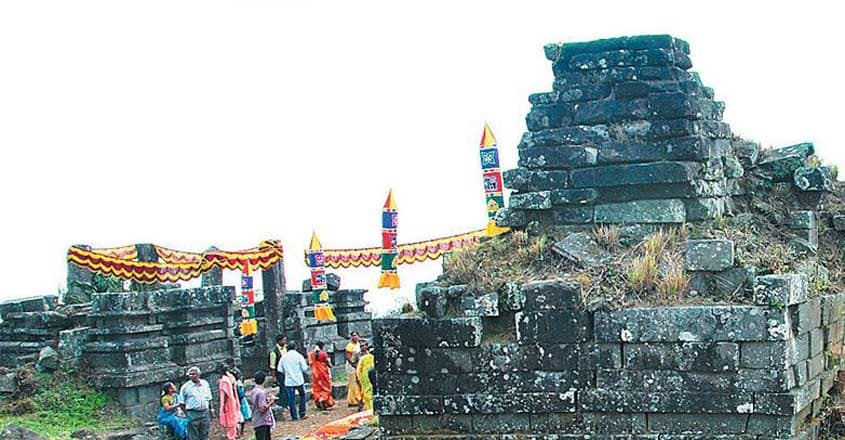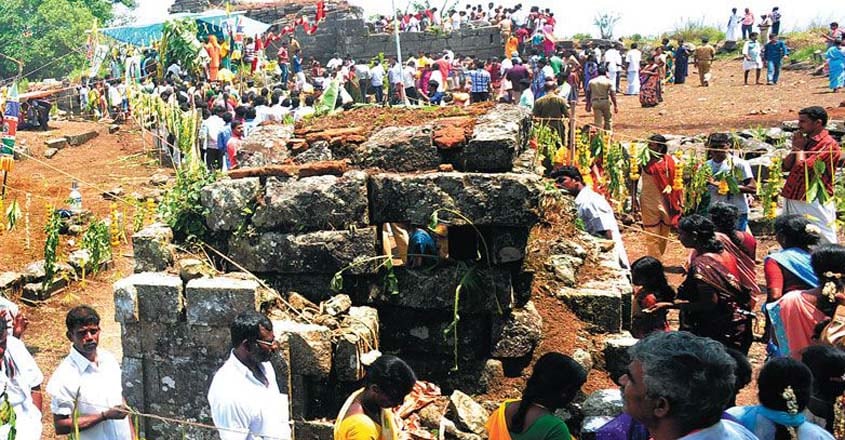A holy trip to Kannagi temple in Idukki

Mail This Article
She epitomizes Indian women's chastity and righteousness. When a shadow of doubt was cast on her dignity and femininity, she burnt down an entire town with her tears. And she is none other than the legendary Tamil woman Kannagi of the epic 'Silappathikaram.'
Kannagi's curse, following the injustice meted out to her, apparently burnt the Madurai town to ashes. Later, it is believed that, Kannagi moved to Surulimalai at Thenni in Tamil Nadu, and from there to Kodungallur in Kerala.
Besides the shrines dedicated to Kannagi in Tamil Nadu, Kerala too has a temple – the Mangaladevi temple – for this revered cultural character.
Let's take a walk through the centuries-old temple, situated in the dense forest near Kumily in Idukki district, which opens only for the Chaitrapournami festival in the Tamil month of Chithirai (April-May) every year.
Journey to Mangaladevi
The temple is 13 kms away from Kumily in Idukki district, and one has to board a jeep from Kumily to reach the hilltop shrine, which is located around 4,000 ft above mean sea level. People are allowed to enter the forest area only on Mangaladevi Temple’s festival day, and there would a sea of humanity for the Chaitrapournami festival. The devotees can visit the temple from 6 am to 4 pm on the festival day. Though there are many jeeps plying on the route, there is a heavy rush of pilgrims.

The forest area, which belongs to the Periyar Tiger Reserve, starts just two km from Kumily. The journey resumed after the routine checking by the forest department officials and police. Travelling through the winding forest path is bit scary. After a while, the jeep stopped on a green hilltop halfway through to the temple. Later, it was a hop from one hilltop to another. There was a nip in the air as the jeep started to scale the heights of hills. The 45-minute drive to the shrine was dotted with panoramic views of the Periyar River and the Thekkady Lake.
At temple's doorsteps
One has to walk for a while, after alighting from the vehicle, to reach the temple. The pristine forest welcomes each and every devotee to the sanctum of divinity on the lap of Mother Nature, and the Mangaladevi Temple reflects a heavenly blend of history and fable.
The temple had been built following the architecture of a bygone era whereby big square granite stones are meticulously arranged to form the structure of the shrine.
The temple is located on a hilltop, a bit away from the forest area. There are four temple structures made of stones with two entry points but one entrance gate is covered in shrubs, wild vegetation and trees. The 'nada panthal' is on the northern side of the temple.

Many portions of the temple are in a state of dilapidation. The four square pillars, each standing 10 feet tall, can take your breath away. The poojas are conducted only in two temple complexes, and one is dedicated to Mangaladevi and the other, which is the biggest, has Shiva as the main deity. The Shiva idol is kept inside a stone. The shrine of Alageshwari is very small and the fourth one is unusable.
The sanctum sanctorum of the Mangaladevi shrine is entirely different from other temples. This hilltop holy place has a one-room sanctum sanctorum without any nada panthal or entrance tower as found in Dravidian temple architecture. The devotees can offer prayers by coming quite near to the idol but there are granite steps which separate the idol from pilgrims.
The Kannagi idol is made of silver and is brought from Kambam in Thenni district in Tamil Nadu for poojas on Chaitrapournami day.
Ancient temple on dispute land
There are some distinctive features to the rituals of the Mangaladevi temple. This might be the only temple that follows the religious customs of both Kerala and Tamil Nadu. It is interesting to note that a Kerala priest conducts the poojas of the Shiva shrine, and Tamilians perform poojas at the adjacent Mangaladevi temple.
Though the temple premises belong to Kerala, there is an ongoing dispute as Tamil Nadu had claimed ownership rights of the hilltop shrine. Pilgrims from Kerala and Tamil Nadu come in droves to the temple on festival day.
The devotees also offer ritualistic offering of porridge (pongala), usually followed in south India, to the deity of the temple.
The history of Mangaladevi temple, assumed to be around 2,000 to 2,500 years old, is still obscure, and there is no solid evidence as to who built the shrine. Legend holds that the temple complexes were built by Senguttuvan Chera after hearing the Kannagi story as told by Illango Adigal in his epic poem 'Silapathikaram.'
Everyone visiting the temple has a question on how the world came to know about this shrine which lied in obscurity deep inside the dense forest.
Devotional worship take a different contour at this shrine. The usual paraphernalia of a temple festival are missing here. There is no elephant or procession. People congregate in large numbers as the temple is opened only once in a year. Here nature sings paeans for the goddess and the devotees return with a content inner self.
Who was Kannagi
Kannagi is the wife of Kovalan, a businessman from Poompuhar. Kovalan incurs heavy losses in his business ventures after his association with dancer Madhavi, and later moves to Madurai along with his wife Kannagi hoping for a turnaround. Kovalan tries to sell his wife's anklet, but the goldsmith takes it to the king and makes him believe that the anklet belonged to the queen that was stolen recently. The king immediately orders the beheading of Kovalan. Following this, Kannagi proves her husband’s innocence by stating that her anklet had emeralds in it, and the queen anklet was made with pearls. Hearing this, the king and queen die on the throne.
Later, Kannagi sets Madurai on fire as she is unable to come to grips with the personal tragedy and the injustice meted out to her.
How to reach
The Mangaladevi temple is located 13 kms from Kumily in Idukki district. The temple opens only once in a year, and this year's Chaitrapournami festival falls on May 10. Many jeep services are available from Kumily to take pilgrims to the temple on the festival day.
Those who wish to offer pongala at the temple should carry requisite materials while visiting the shrine. Keep in mind that plastics are not allowed.

